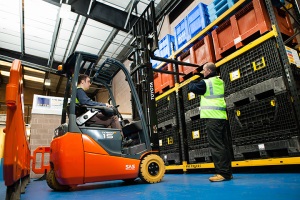Complete Powerpoint slide presentation for forklift instructors. Ready made training course
what is an authorisation to operate and do i need one?
 This useful article is by RTITB and was first published in their blog on 26th April 2019.
This useful article is by RTITB and was first published in their blog on 26th April 2019.
Contrary to belief, it is the responsibility of the employer to issue an authorisation to operate a lift truck, not the instructor who delivers the operator training. We explain what an ‘authorisation to operate’ is, when it should be issued and how to manage the process properly to ensure safety and compliance.
Under no circumstance should an employer allow anyone to operate a lift truck on their premises without an “authorisation to operate”.
It is the employer’s responsibility (not the instructor) to issue the authorisation, which applies to anyone operating a lift truck full-time, occasionally and even very rarely.
In other words, without an authorisation to operate, staff should not be expected to use the equipment. There are no excuses, particularly in a busy real-world setting when it seems so easy just to “move a pallet truck out of the way”, for example.
What is “Authorisation to operate”
An authorisation to operate can be granted by the employer when it is satisfied that the employee has competently completed the three stages of training (Basic, Specific and Familiarisation).
Before an authorisation to operate is issued (in writing or via an electronic system), the employer should have a clear record of all of the training that was completed, when and on what type of machine. All authorisations should be logged and recorded and include:
- Operators name
- Expiry date of the authorisation
- Date authorisation granted
- Types/categories of equipment operator is authorised to use
- Any special limitations or conditions associated with the authorisation
- The areas of the company’s premises in which the operator is authorised to operate
Note that an authorisation to operate is not a general authorisation, it is specific to the tasks the operator will complete, including the specific truck type and capacity and the load types.
The three stages of lift truck training
To ensure safe operation of vehicles in the workplace, employers should invest in training for lift truck operators (and their instructors) which follows three stages, helping to ensure legal compliance as set out in this advice note from the HSE.
1) Basic Operator Training
As well as learning to operate the machine, operators learn about the risks and hazards associated with operation. It covers important skills such as pre-use inspection and routine basic maintenance like refuelling or battery care. Basic training takes place ‘off-the-job’ and provides the knowledge to operate safely and efficiently.
2) Specific Job Training
This is where the operator learns about the operating principles specific to the equipment they will be using and how the lift truck is used in their workplace. Specific training also takes place ‘off-the-job, away from work pressures.
3) Familiarisation Training
This applies what has been learnt during Basic and Specific training, ‘on-the-job’ but still under close supervision
Employers should ensure that these three areas of training are completed before written authorisation to operate is given. Training can be conducted in house or by outsourcing to a training provider.
Supervision is essential
An authorisation is not a guarantee of safe operation as there are many other factors such as safe systems of work, and supervision required. Instructors and employers should continue to monitor and assess an operator’s ability and identify where any remedial, refresher or conversion training may be required.
What happens if there is no authorisation?
The Provision and Use of Work Equipment Regulations 1998 (PUWER) requires that equipment provided for use at work is used only by people who have received adequate information, instruction and training.
Failure to ensure an operator has an authorisation to operate puts an employer at risk of prosecution in the event of an incident being caused by an unauthorised operator.
More importantly, with no authorisation and potentially no training, the risk of an incident sadly increases significantly.
There are few exceptions where authorisation is not needed, however one such exception is a trainee operating under close supervision during training.
Changing jobs and moving roles:
In the event an operator moves roles or to a new place of employment, their authorisation does not move with them. The new employer should review competence, train as required and issue a new authorisation, where permitted.
In the event any new tasks/machinery are introduced to the operator, the relevant training needed should be conducted and a new authorisation to operate be issued, to highlight the new changes in circumstance.
Can you revoke an authorisation to operate?
If an operator fails to meet the required standards during refresher training, is involved in an incident, has been off work for an extended period or during an assessment of their skills, their authorisation to operate should be revoked
It should only be reissued when there is documented evidence that they have completed any necessary training and have met the required standard of competence again.
All training completed should be accurately logged in the operators Training Record.
Disclaimer. The legislative information contained on this web site is my interpretation of the law based on many years in the health and safety business. A definitive interpretation can only be given by the courts. I will therefore not be held responsible for any accident/incident/prosecution arising as a consequence of anyone using any information obtained from this web site.